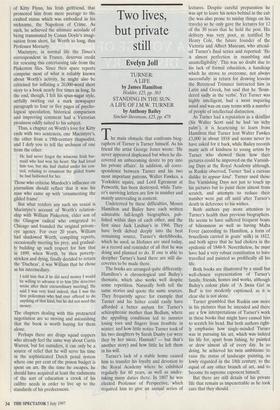Two lives, but private still
Evelyn Joll
The main obstacle that confronts biog- raphers of Turner is Turner himself. As his friend the artist George Jones wrote: 'He never appeared displeased but when he dis- covered an unbecoming desire to pry into his private affairs'. In addition, all corre- spondence between Turner and his two most important patrons, Walter Fawkes, a Yorkshire squire, and Lord Egremont at Petworth, has been destroyed, while Turn- er's surviving letters are few in number and mainly unrevealing in content.
Undeterred by these difficulties, Messrs Hamilton and Bailey have each written admirable full-length biographies, pub- lished within days of each other, and the first since Jack Lindsay's in 1966. They have both delved deeply into the best remaining source, Turner's sketchbooks, which he used, as filofaxes are used today, as a record and reminder of all that he was doing and planned to do. If one is able to decipher Turner's hand there are still dis- coveries to be made there.
The books are arranged quite differently: Hamilton's is chronological and Bailey's thematic, which also works well despite some repetition. Naturally both tell the same stories and quote the same sources. They frequently agree: for example that Turner and his father could easily have afforded a better asylum for Turner's schizophrenic mother than Bedlam, where the appalling conditions led to inmates losing toes and fingers from frostbite in winter; and how little notice Turner took of his two daughters by Sarah Danby (or were they by her niece, Hannah? — but that's another story) and how little he left them in his will.
Turner's lack of a stable home caused him to transfer his loyalty and devotion to the Royal Academy where he exhibited regularly for 60 years, as well as under- taking many duties there. In 1807 he was elected Professor of Perspective, which required him to give an annual series of lectures. Despite careful preparation he was apt to leave his notes behind in the cab (he was also prone to mislay things on his travels) so he only gave the lectures for 12 of the 30 years that he held the post. His delivery was very poor, as testified by Henry Cole, the future founder of the Victoria and Albert Museum, who attend- ed Turner's final series and reported: 'He is almost perfection in mumbling and unintelligibility'. This was no doubt due to his lack of formal education, a handicap which he strove to overcome, not always successfully: in return for drawing lessons the Reverend Trimmer instructed him in Latin and Greek, but said that he 'floun- dered sadly in the verbs'. Yet Turner was highly intelligent, had a most inquiring mind and was on easy terms with a number of people of intellectual distinction.
As Turner had a reputation as a skinflint (Sir Walter Scott said he had 'an itchy palm'), it is heartening to learn from Hamilton that Turner lent Walter Fawkes £3,000 in about 1818 and seems never to have asked for it back, while Bailey records many acts of kindness to young artists by Turner who showed them how their pictures could be improved on the Varnish- ing Days at the Royal Academy although, as Ruskin observed, Turner tad a curious dislike to appear kind'. Turner used those five Varnishing Days not just to touch up his pictures but to paint them almost from scratch, and attempts to reduce their number were put off until after Turner's death in deference to his wishes.
Both authors pay more attention to Turner's health than previous biographers. He seems to have suffered frequent bouts of biliousness as well as having Malta Fever (according to Hamilton, a form of brucellosis carried in goats' milk) in 1812, and both agree that he had cholera in the epidemic of 1848-9. Nevertheless, he must have had a very robust constitution to have travelled and painted so prolifically all his life.
Both books are illustrated by a small but well-chosen representation of Turner's family, friends, homes and works, although Bailey's colour plate of 'A Swiss Girl in Bed' is too modestly captioned, as it is clear she is not alone.
Turner grumbled that Ruskin saw more in his pictures than he intended and there are a few interpretations of Turner's work in these books that might have caused him to scratch his head. But both authors right- ly emphasise how single-minded Turner was in pursuing his art, which was indeed his life for, apart from fishing, he painted or drew almost all of every day. In so doing, he achieved his twin ambitions: to raise the status of landscape painting, so lowly regarded in the 18th century, to the equal of any other branch of art, and to become its supreme exponent himself.
But there are still details of his private life that remain as impenetrable as he took care that they should.


























































 Previous page
Previous page